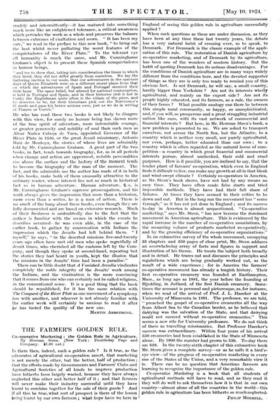THE FARMER'S GOLDEN RULE.
Is there then, indeed, such a golden rule ? Is it true, as the advocates of agricultural co-operation assert, that marketing is not merely the other, but the better, half of production ; that the efforts made by Governments and Farmers' Clubs and Agricultural Societies of all kinds to improve production have hitherto been largely wasted, because they have always neglected this other and better half of it ; and that farmers will never make their industry successful until they have learnt to combine together for the sale of their goods ? And if all this be true, what sort of prospect is there of the lesson being learnt by our own farmers ; what hope have we here in
England of seeing this golden rule in agriculture successfully applied ?
When such questions as these are under discussion, as they have been at any time these last twenty years, the debate has a very natural habit of crossing over, so to speak, to Denmark. For Denmark is the classic example of the appli- cation of this rule. The restoration of Danish agriculture by co-operative marketing, and of Denmark by its agriculture, • has been one of the wonders of modern history. But the habit of quoting Denmark has its serious disadvantages.. Far the conditions of Danish agriculture are in many ways widely different from the conditions here, and the devoted supporter of things as they are is only too ready to remind you of this obvious fact. Is not Denmark, he will say, a small country, hardly bigger than Yorkshire ? Are not its interests wholly agricultural, and mainly on the export side ? Are not its people highly educated, and its farmers, as a rule, the owners of their farms ? What possible analogy can there be between this simple rural community, so happy, so unsophisticated, and, if you will, so prosperous and a great struggling industrial nation like ours, with its vast network of commercial and financial interests ? But here, in Mr. Herman Steen's book, a new problem is presented to us. We are asked to transport ourselves, not across the North Sea, but the Atlantic, to a country which is neither very small, nor purely agricultural, nor even, perhaps, better educated than our own ; to a country which is often regarded as the natural home of com- petition—a country in which great financial and commercial interests pursue, almost unchecked, their cold and cruel purposes. How is it possible, you are inclined to say, that the tender plant of farmers' co-operation, which even in England finds it difficult to live, can make any growth at all in that bleak and wind-swept climate ? Certainly co-operators in America, as Mr. Steen's book shows, have not had by any means an easy time. They have often made false starts and tried impossible methods. They have had their full share of failures. At times they have seemed to their critics to be down and out. But in the long run the movement has " come through," as it has not yet done in England ; and its success to-day in America is almost unquestioned. "Co-operative marketing," says Mr. Steen, " has now become the dominant movement in American agriculture. This is evidenced by the rapid increase in the number of co-operative associations, by the mounting volume of products marketed co-operatively, and by the growing efficiency of co-operative organizations."
In an exhaustive survey of the whole movement, occupying 35 chapters and 350 pages of close print, Mr. Steen adduces an overwhelming array of facts and figures in support and illustration of his theme. He treats the 'subject both broadly and in detail. He traces out and discusses the principles and regulations which are being gradually worked out, as the result of a wide experience ; for in America the farmers' co-operative movement has already a longish history. Their first co-operative creamery was founded at Easthampton, Mass., as long ago as 1881, the year before the founding at Hjedding, in Jutland, of the first Danish creamery. Some- times the account is personal and picturesque, as, for instance, when we read of the arrival of Prof. J. L. Haecker at the University of Minnesota in 1891. The professor, we are told, " preached the gospel of co-operative creameries all the way from Albert Sea to the Canadian border, as he believed that dairying was the salvation of the State, and that dairying could not succeed without co-operative creameries." This seems a new role for University professors. We do not think of them as travelling missionaries. But Professor Haecker's success was extraordinary. Within four years of his arrival 350 creameries had been established in the State of Minnesota alone. By 1900 the number had grown to 550. To-day there are 638. In the twenty-sixth chapter of this exhaustive book Mr. Steen gives a complete survey—or as he calls it a bird's- eye view—of the progress of co-operative marketing in every one of the States of the Union, and a very remarkable view it is. There can be no question that American farmers are learning to recognize the importance of the golden rule.
Co-operative Marketing is a book that all students of agricultural methods will have to read, and as they read it they will do well to ask themselves how it is that in our own country—almost alone of all the countries in the world—this golden rule in agriculture has been hitherto so much neglected.
PHILIP MORRELL. -






































 Previous page
Previous page